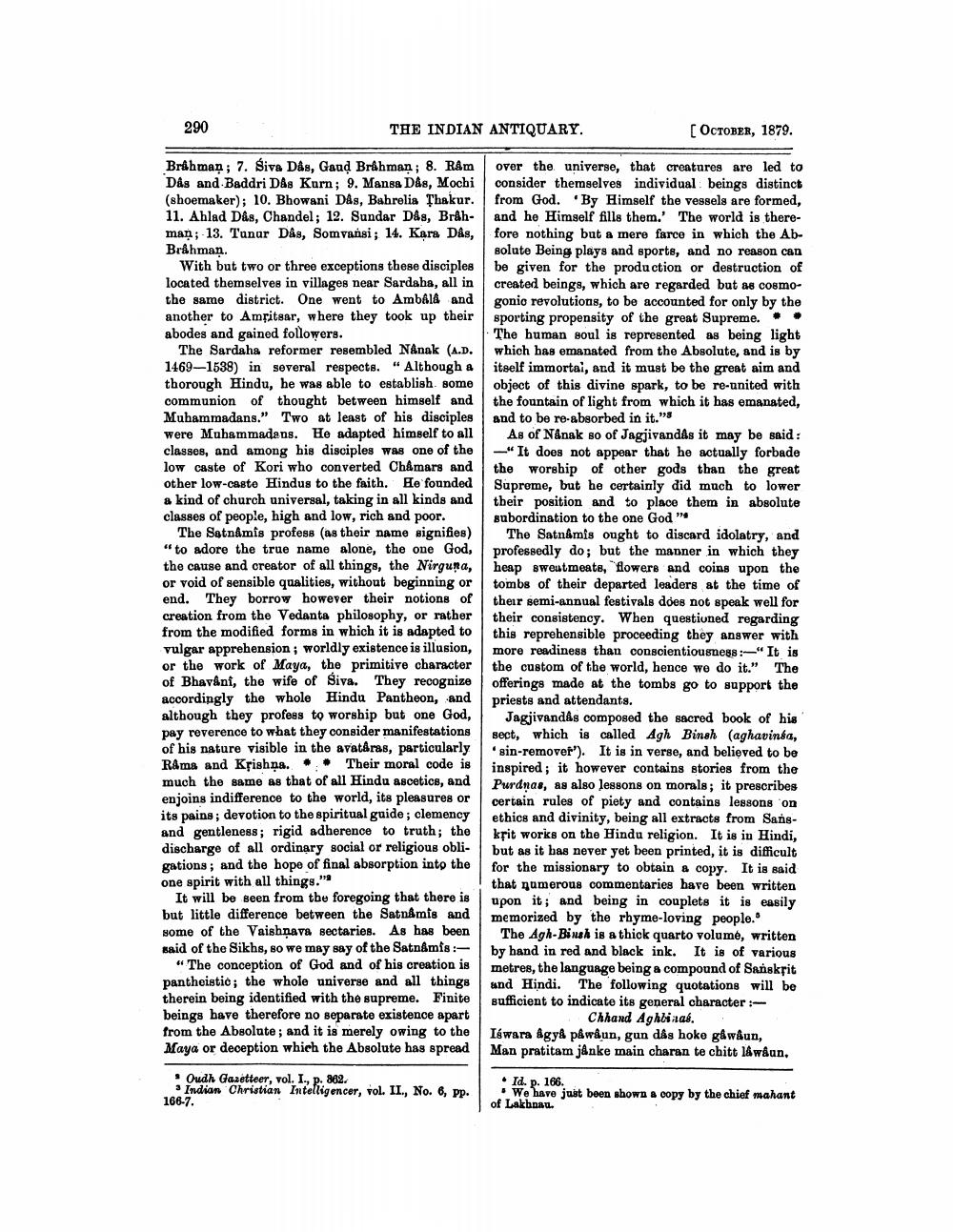________________
290
THE INDIAN ANTIQUARY.
Brahman; 7. Śiva Dâs, Gauḍ Brahman; 8. Râm Dâs and Baddri Dâs Kurn; 9. Mansa Dâs, Mochi (shoemaker); 10. Bhowani Dâs, Bahrelia Thakur. 11. Ahlad Dâs, Chandel; 12. Sundar Dâs, Bråhman; 13. Tunur Dâs, Somvansi; 14. Kara Dâs, Brahman.
With but two or three exceptions these disciples located themselves in villages near Sardaha, all in the same district. One went to Ambala and another to Amritsar, where they took up their abodes and gained followers.
The Sardaha reformer resembled Nanak (A.D. 1469-1538) in several respects. "Although a thorough Hindu, he was able to establish some communion of thought between himself and Muhammadans." Two at least of his disciples were Muhammadans. He adapted himself to all classes, and among his disciples was one of the low caste of Kori who converted Chamars and other low-caste Hindus to the faith. He founded a kind of church universal, taking in all kinds and classes of people, high and low, rich and poor.
The Satnamis profess (as their name signifies) "to adore the true name alone, the one God, the cause and creator of all things, the Nirguna, or void of sensible qualities, without beginning or end. They borrow however their notions of creation from the Vedanta philosophy, or rather from the modified forms in which it is adapted to vulgar apprehension; worldly existence is illusion, or the work of Maya, the primitive character of Bhavânî, the wife of Siva. They recognize accordingly the whole Hindu Pantheon, and although they profess to worship but one God, pay reverence to what they consider manifestations of his nature visible in the avataras, particularly Rama and Krishna. Their moral code is much the same as that of all Hindu ascetics, and enjoins indifference to the world, its pleasures or its pains; devotion to the spiritual guide; clemency and gentleness; rigid adherence to truth; the discharge of all ordinary social or religious obligations; and the hope of final absorption into the one spirit with all things."
It will be seen from the foregoing that there is but little difference between the Satnamis and some of the Vaishnava sectaries. As has been said of the Sikhs, so we may say of the Satnâmis:
"The conception of God and of his creation is pantheistic; the whole universe and all things therein being identified with the supreme. Finite beings have therefore no separate existence apart from the Absolute; and it is merely owing to the Maya or deception which the Absolute has spread
[OCTOBER, 1879.
over the universe, that creatures are led to consider themselves individual beings distinct from God. By Himself the vessels are formed, and he Himself fills them.' The world is therefore nothing but a mere farce in which the Absolute Being plays and sports, and no reason can be given for the production or destruction of created beings, which are regarded but as cosmogonic revolutions, to be accounted for only by the sporting propensity of the great Supreme. The human soul is represented as being light which has emanated from the Absolute, and is by itself immortal, and it must be the great aim and object of this divine spark, to be re-united with the fountain of light from which it has emanated, and to be re-absorbed in it.""
Oudh Gazetteer, vol. I., p. 862.
3 Indian Christian Intelligencer, vol. II., No. 6, pp.
166-7.
As of Nanak so of Jagjivandas it may be said: "It does not appear that he actually forbade the worship of other gods than the great Supreme, but he certainly did much to lower their position and to place them in absolute subordination to the one God"
The Satnamis ought to discard idolatry, and professedly do; but the manner in which they heap sweatmeats, flowers and coins upon the tombs of their departed leaders at the time of their semi-annual festivals does not speak well for their consistency. When questioned regarding this reprehensible proceeding they answer with more readiness than conscientiousness:-"It is the custom of the world, hence we do it." The offerings made at the tombs go to support the priests and attendants.
Jagjivandas composed the sacred book of his sect, which is called Agh Binsh (aghavinsa, sin-remover"). It is in verse, and believed to be inspired; it however contains stories from the Purdnas, as also lessons on morals; it prescribes certain rules of piety and contains lessons on ethics and divinity, being all extracts from Sanskrit works on the Hindu religion. It is in Hindi, but as it has never yet been printed, it is difficult for the missionary to obtain a copy. It is said that numerous commentaries have been written upon it; and being in couplets it is easily memorized by the rhyme-loving people."
The Agh-Biush is a thick quarto volumé, written by hand in red and black ink. It is of various metres, the language being a compound of Sanskrit and Hindi. The following quotations will be sufficient to indicate its general character:Chhand Aghbinas. Iswara Agyå påwåun, gun dâs hoke gåwåun, Man pratitam janke main charan te chitt lawâun.
Id. p. 166.
We have just been shown a copy by the chief mahant of Lakhnau.




